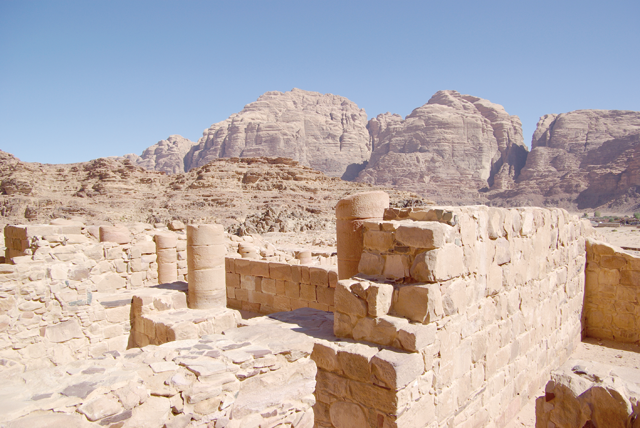You are here
Ancient cultic architecture: focusing on Syro-Arabian shrines’ structures
By Saeb Rawashdeh - Apr 16,2024 - Last updated at Apr 16,2024

Consecutive open courtyard shrines at Timna Valley Site 2. View of the earlier shrine from the southeast, with altar at the centre, and basin and row of standing stones in the back left corner (Photo courtesy of Juan Tabes)
AMMAN — The religion of the people who lived in the Syro-Arabian Desert and the steppes during the final phase of the Late Bronze and the Iron Ages (around 1300–550 BC) is shrouded with mystery due to the lack of primary sources.
Only a few local epigraphic evidences of relevance have been found and the scattered references in the outside sources, such as Biblical texts, Egyptian, Assyrian and Babylonian inscriptions, have provided very little, although vital, information on their cults.
Five extramural shrines dated to the Late Bronze/Iron Age (LB/IA) have been excavated in the southern arid margins of the Levant: two at Timna, and one at Horvat Qitmit, ‘EnHazeva (Naqab) and Wadi at-Thamad (in south-central Transjordan).
“Although previous studies on their architecture and finds have provided lots of data, the scholars have often analysed these shrines within the religious background of the contemporary settled societies of the Levant and Egypt, without adequate research on the long history of local cultic architecture produced by the seminomadic pastoral peoples who inhabited the area,” noted Juan Tebes, from the Catholic University of Argentina.
Talking about Timna Site in Naqab, Tebes said that the earliest cultic structures dated with certainty to this period are located there.
“The New Kingdom Egyptians exploited the rich copper resources of this area during the 14th– 12th centuries BC, bringing with them their rich religious heritage. They directed and worked together with a local workforce coming from the pastoral population and the oasis towns of north-western Arabia,” Tebes underlined, adding that, together with the founding of mining and smelting camps, they also established cultic structures intended for the worship of Egyptian deities.
While their shrines were built according to the standard Egyptian designs, these Egyptian shrines functioned close to extramural sanctuaries established by the local populations, taking at the same time architectural elements and cultic paraphernalia from the millennia-old local cultural heritage.
Timna was a hub for copper production and therefore a smelting camp was located on a flat terrain on the northern side of the valley and close to the mining area, where archaeologists excavated two superimposed extramural shrines, known as the “Semitic” shrine.
Wadi at Thamad, in the Jordan Valley, is another important site and cultic place from that historical period. This small site was established in the south-central Transjordanian region, known in the IA as Moab, on a flat hilltop overlooking a wadi and relatively isolated from dwelling sites (the closest site is Khirbet ar-Rumayl, located 350metres to the north).
“The excavations revealed the two major phases of occupation that extended intermittently during the Late Iron I to Iron II periods (11th/10th centuries –8th/7th centuries BC),the earliest layer (Late Iron I–Early Iron II) consisted of fivecooking installations not associated with any architecture. Wadi at Thamad was probably a place where communalmeals were consumed, evidence of which can be seen in a heavy ash layer with ceramicsherds [cooking pots and serving vessels] and abundant processed animal bones that covered the installation,” said Tebes.
None of the finds in this phase seems to be related with cultic activities, but the
remains of meals in this extra-mural location can be interpreted as evidence of food offerings for the dead, who were buried in nearby Khirbetar-Rumayl.
“The most common type of cultic architecture was the open-air courtyard shrine, basically an artificially closed space delimited by a line or low wall of stones, often situated along trade routes or close to dwelling sites,” noted Tebes, adding that according to the analysis of the open-air courtyard shrines known in the Naqab and Sinai most shrines (70.7 per cent) fall within two categories: the first type is a rectangular courtyard with an elongated cella at the back, made of stone courses or standing stones; the second type is a quadrangular courtyard with a circular stone installation or standing stone in the centre.
Other shrines had circular or semi-circular plans, he said.
Related Articles
AMMAN — Pilgrimage routes in the Levant and Hijaz have been a topic of research for the past decades when archaeologists and historians stud
AMMAN — The places of worship tend to have different architectural shapes through the history of religious practice.
AMMAN — Pella, an ancient site located approximately 100 kilometres northwest from Amman, was discovered in 1818 by Charles Irby and James M


















